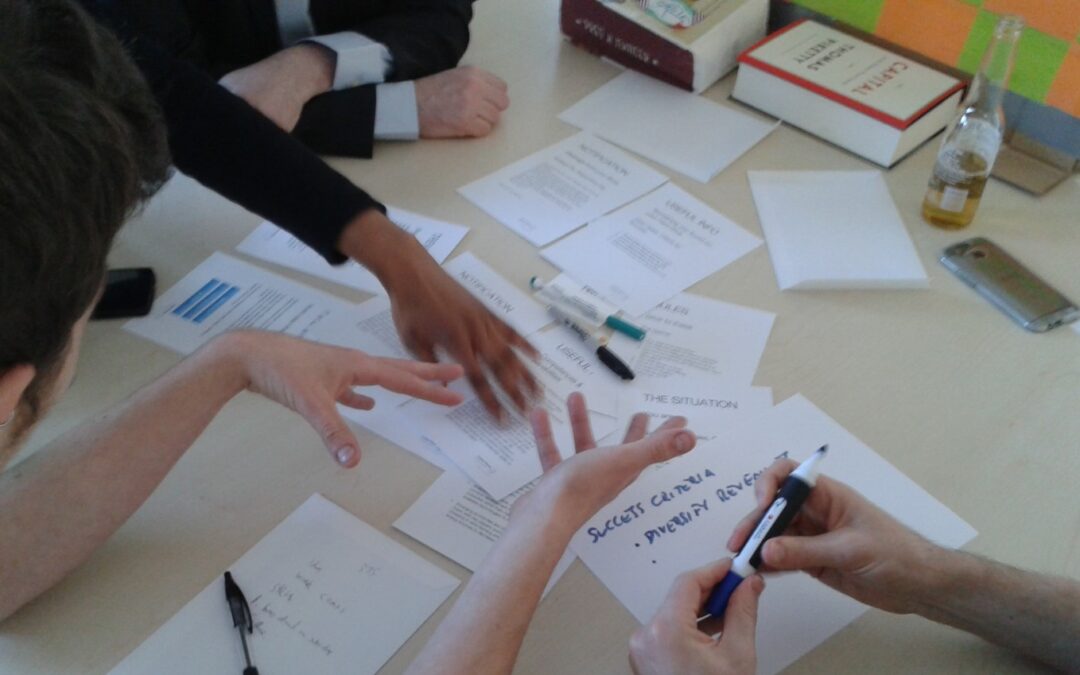Meetings are a drain on resources. Even in meetings with clear value, a palpable sense of unease can be felt in acknowledgement of the mounting loss of productivity. By some estimates, time wasted in meetings costs the UK economy £26 billion a year.
There is much literature on how to reduce the number and length of meetings; but while this is important, companies’ entire meeting culture needs shaking up. Meetings must address a particular need of an organisation and should be designed to fit this purpose. There is no one size fits all approach.
In my time researching management techniques for our knowledgebase, I have learnt some key lessons about 21st Century business from both emerging theory and case studies, and in doing so I have come across a few meeting techniques that are worth considering. Here are three of them.
Peer-to-Peer Coaching in Shared Reporting Lines
This is a technique endorsed by Keith Ferrazzi of Ferrazzi Greenlight, a consultancy. It integrates the staff meeting with peer-to-peer coaching among employees who report to the same manager.
As in a typical staff meeting, it begins with a rapid status update. The bulk of the meeting should then be spent discussing any blockers identified by those present from reports sent in advance. Attendees then break into smaller groups and debate a topic. Decision-making power remains with the person who surfaced each issue, and the meeting serves as a forum to clarify problems and seek support.
The technique can be greatly effective in large companies that are heavily siloed and where leaders do not have the time to coach employees. It provides clear value in that it addresses a particular need and is designed accordingly; sending reports in advance ensures attendees don’t dwell on their content. The result is that a peer-to-peer network is created, where people who share reporting lines come to see each other as sources of advice.
Impartial Facilitator Meeting Method
Buurtzorg is a nursing organisation which consists of 7,000 nurses working in self-managing teams. The Impartial Facilitator Meeting Method is a way of making decisions in the absence of formal leaders.
The meeting is convened with no prior agenda. A facilitator is selected whose role is not to make any suggestions or decisions, but to assort the agenda based on what is raised by those present. A succession of rounds take place where the various proposals are introduced, discussed and refined, and then lastly put to a decision. Proposals are passed if nobody has a principled objection.
The meeting technique is effective as it is designed to fit its purpose; the impartiality of the facilitator removes the threat of them attempting to force the agenda, and the loose criteria for passing a proposal avoids gridlock- important in an organisation with no formal hierarchy to usher things through. Moreover, it institutes fluid and flexible hierarchies by helping leaders naturally emerge based on influence, expertise or recognition.
Exchange Meetings
Exchange meetings occur at HSBC between managers and a small number of their direct reports. They provide a platform for employees to talk about anything they want to.
The manager calls a meeting with no agenda, inviting roughly 10 direct reports. Employees are then free to discuss anything they like, often surfacing issues that the manager was not previously aware of, or thought had been solved.
Exchange meetings were implemented to address trust and cultural issues that have caused significant problems for the bank over the past decade. HSBC formerly enforced a top down culture and the initiative has helped improve the flow of communication, ultimately leading to more engaged employees. Vital because after all, employees will be more inclined to break the law and incur fines for a company if they feel they have no stake in its wellbeing.
Conclusion
These three techniques (just like others we have catalogued) have very different roles to play in team operations, but are effective because they address a particular organisational need or pain point and are structured accordingly. Peer-to-Peer Coaching in Shared Reporting Lines provides an employee support function where leaders have no time for coaching, whereas the Impartial Facilitator Meeting Method enables a self-managing team to make decisions while facilitating the emergence of leaders, and Exchange Meetings vastly improve communication in a firm where it has been sorely lacking.
To reform your meeting culture, tailor the structure of your meetings to fit their purpose, and their purpose to fit the current needs of the firm. Meetings cause waste when they become habitual and we forget why they have been called. As different challenges arise and priorities shift, a corresponding change in how, why, and when you meet should take place.
During my three months working as an intern at Postshift, we have started holding consulting stand ups every morning where we list priorities for the day and state any potential tensions or obstructions. The process is quick- important given they are a daily occurrence- and addresses a particular need in that, by identifying any potential problems early on, the need for time-consuming crisis meetings is avoided.
The technique also sees Postshift embracing what has been one of the most prevalent themes in my research; that of transparency.

